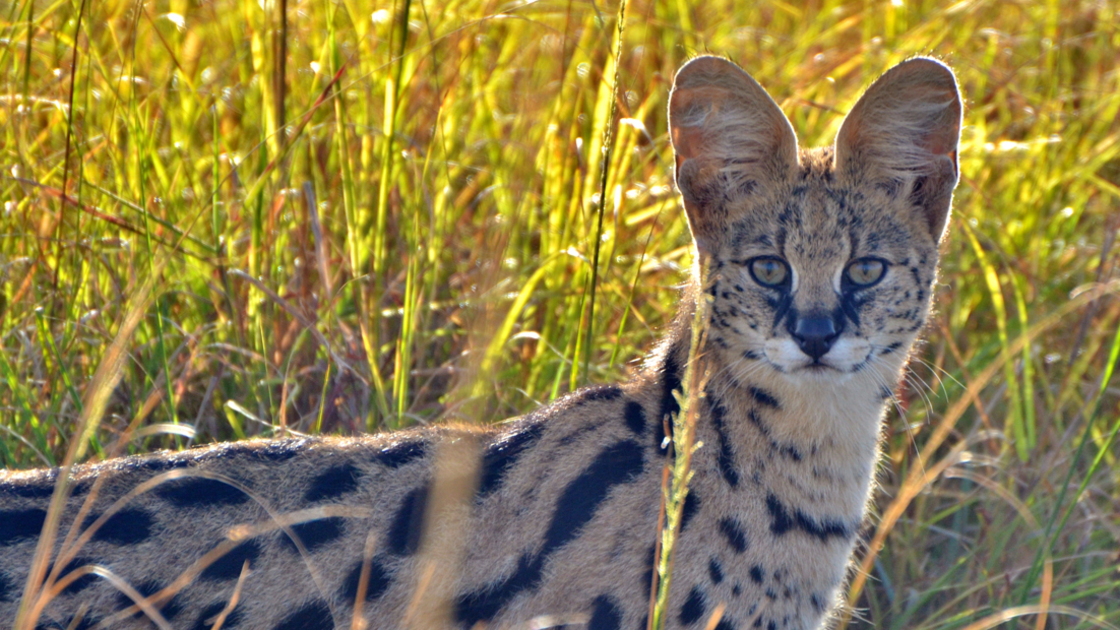When most people ponder impressive cats, they think about lions, cheetahs, leopards or their own domestic tabby named something similar to “Tigger.” These felines are definitely awe-worthy in their own respect: The lion is the king of the jungle, the leopard is the embodiment of stealth, and the cheetah is the king of speed when it comes to land animals (you’ll have to figure out the wonderful thing about Tiggers on your own). In just three strides, a cheetah can reach up to 60 miles per hour; its top speed is 75 mph. Even the domestic tabby is impressive when it stealthily hunts, kills and leaves you a “gift” on your front doorstep (although maybe not impressive at the time). Even though all of these cats are indeed impressive, this article’s spotlight will be on the second-fastest feline, which is considerably less well-known: the serval.
The serval is a medium-sized wild cat that is native to the African continent. Getting its name from a Portuguese word meaning “wolf-deer,” this feline can look a bit disproportionate at first glance. It is also called the “giraffe cat” because of its unusually elongated neck. Sometimes it is referred to as the “cat of spare parts.” It has won these references because its body is made up of extremes. Compared to larger felines—like lions—it has the longest legs in relation to the rest of its body. In an open run, a serval can reach speeds up to 45 mph—only 15-30 mph less than a cheetah.
The serval’s legs are not mainly used for swift chases like a cheetah; instead, it uses its long neck and stilt-like legs to look over the tall sub-Saharan grasses of the field for a tasty meal. Its long legs also give the serval the ability to spring into the air when need be. If it’s hunting fowl and the bird takes flight to avoid the hungry feline, then the serval will surprise it by jumping up to 10 vertical feet! It then claps its two paws together, capturing its target and driving it to the ground.
If you don’t think that’s impressive, consider the serval’s ears. According to the Smithsonian Channel, its oversized ears would be equivalent to humans having plate-sized ears! Imagine that. But the serval definitely doesn’t mind because its ears come in handy when hunting during the night or in dense grasses. Because of its large ear size, the serval’s hearing sensitivity is dramatically heightened, enabling the serval to detect its prey by listening to the echoes around it; this is called echolocation or biosonar. This even makes it possible for the serval to capture prey that live underground! But this requires a patient serval. If need be, the serval will wait up to 15 minutes while listening to the movements of its desired target. Sometimes, the serval won’t even see its prey until the very moment that it pounces. Could you imagine having to rely on your ears the way the serval does?
The good news is that we don’t have plate-sized ears, and that is exactly what God intended. He created us exactly the way He wanted to—and that is in His image (Genesis 1:27). He also used great wisdom while creating every creature that walks the Earth (Psalm 104:24-25). God put diligent thought into designing even the wild serval’s extreme body.
While at first glance the serval looks a bit awkward, finding out a little more about it shows how imaginative and thought-provoking God’s creative process is. God created the serval with its unique hunting and hearing capabilities knowing it would have to survive in the grasslands of Africa. He also considered the surrounding environment and the other animals that would share its ecosystem in order to create a suitable home. And He did! He created it all, and He did it perfectly.
Animals may just be animals, and cats may just be cats—and a serval may just be an odd-looking one at that—but when you consider the creative process and the time God put into producing the serval, then the odd attributes it has suddenly manifest themselves into beauty. Just as the heavens declare the glory of God (Psalm 19:1), so does God’s handiwork on the Earth. Take some time and research a part of nature that you find odd or extreme. You’ll probably find that things you observe as oddities were perfectly designed for that creature’s needs and environment. That’s a witness of the creative genius of God. And who knows, you might even pick up some ideas for something you’d like to create in the future!
